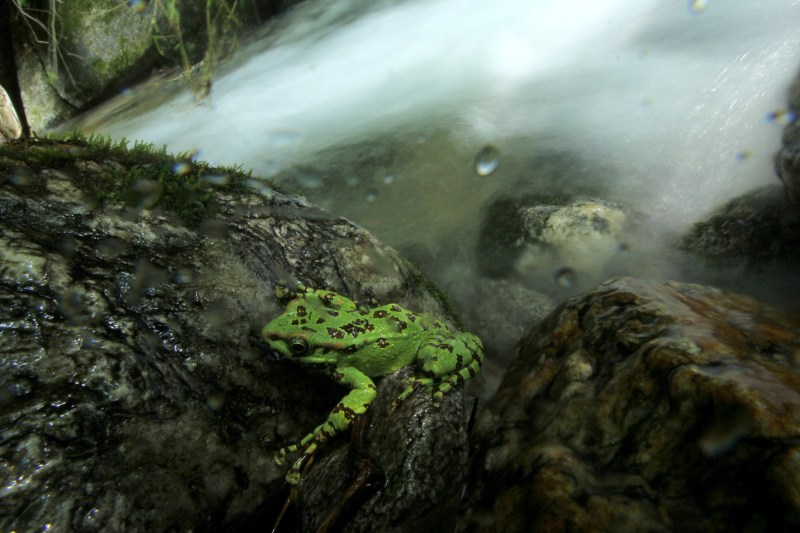A spectacular crocodile newt from the Central Highlands of Vietnam was just published in the international peer-reviewed open-access academic journal ZooKeys.
“It is an exceptional discovery as it is one of the most colourful species in the genus Tylototriton. This is also the first time that a crocodile newt species is recorded from the Central Highlands of Vietnam. Occurring at elevations from 1,800 to 2,300 m above sea level, this discovery sets an elevational record for the genus in the country, with former distribution ranges between 250 m and 1,740 m.”
says discoverer and first author of the study Trung My Phung.
Furthermore, the discovery by the Vietnamese-German researcher team, which was supported by the Vietnam Academy of Science and Technology and the Cologne Zoo (Germany), represents the southernmost distribution range of the genus known to date.
The habitat of the new species is located approximately 370 air km away from the nearest Tylototriton population, which makes it an important discovery in terms of evolution and zoogeography.
The name “ngoclinhensis” refers to the type locality of the new species, Ngoc Linh Mountain. Restricted to evergreen montane forest, the Ngoc Linh Crocodile Newt is currently known only from the Ngoc Linh Nature Reserve, Kon Tum Province, in the Central Highlands of Vietnam. This is the eighth salamander taxon described from Vietnam, and is the thirty-ninth Tylototriton species officially recognized.

Photo by Prof. Dr. Tao Thien Nguyen.
Crocodile newts, scientifically known as the genus Tylototriton, include nearly 40 species inhabiting montane forest areas throughout the Asian monsoon climate zone. Remarkably, 15 of these species have been described in the past five years, and there remain several unnamed taxa, which contain cryptic species that are morphologically difficult to distinguish.
Established in 1986, Ngoc Linh Nature Reserve is a key biodiversity area for rare species like the endangered Golden-winged Laughingthrush and the Truong Son Muntjac. The Ngoc Linh Crocodile Newt certainly will represent another flagship species of this protected area and its surroundings, say the researchers.
Ngoc Linh has become a hotspot of amphibian diversity, with numerous endemic species. An earlier study – published in the Nature Conservation journal in 2022 – highlighted the extraordinary endemism rate of amphibians in the Central Highlands of Vietnam.
“[The Central Highlands is] where the highest amphibian species diversity was recorded for Vietnam, with 130 species, while also containing the highest number of regionally occurring, micro-endemic amphibians, amounting for 26 species,”
explains one of the authors of this and the present study, Prof. Dr. Truong Quang Nguyen, vice director of the Institute of Ecology and Biological Resources (IEBR), Hanoi.
This recent discovery is another remarkable case, “demonstrating that the Central Highlands play a special role in Vietnamese amphibian diversification and evolution,” by the words of co-author Dr. Cuong The Pham from IEBR.
The Ngoc Linh Crocodile Newt belongs to the group of range-restricted, so-called micro-endemic species, which face the greatest risk of extinction because of their presumably small population size. Unfortunately, on top of its special zoogeographic situation and rarity, its particularly colorful appearance will likely make it highly attractive to illegal collectors.
“Therefore, this discovery is of high conservation relevance,”
says one of the corresponding authors, Prof. Dr. Tao Thien Nguyen from the Institute of Genome Research, Hanoi.
The species should be provisionally considered to be listed as Endangered on the IUCN Red List of threatened species, the researchers say. All the species of the genus Tylototriton are already listed in the Appendices of the Convention on International Trade in Endangered Species of Wild Fauna and Flora (CITES) and also in the Governmental Decree No. 84/2021/ND-CP of Vietnam. The new species thus is automatically protected under these regulations.
Now, conservation activities on site have priority, but the team is already working on breeding conservation measures, which is in line with the One Plan Approach to Conservation, developed by IUCN’s Conservation Planning Specialist Group, which combines in-situ and ex-situ efforts and various expertises for the optimum protection of a species.
“This has already been successfully implemented for another recently discovered, micro-endemic crocodile newt species from Vietnam, Tylototriton vietnamensis, of which already more than 350 individuals could have successfully been reproduced at the Cologne Zoo in Germany and also at the Melinh Station for Biodiversity in Vietnam, which is a promising example for IUCN’s Reverse the Red campaign and the idea of the conservation zoo”,
says Prof. Dr. Thomas Ziegler, Vietnam conservation team member and coordinator from Cologne Zoo, Germany.
***
Research article:
Phung TM, Pham CT, Nguyen TQ, Ninh HT, Nguyen HQ, Bernardes M, Le ST, Ziegler T, Nguyen TT (2023) Southbound – the southernmost record of Tylototriton (Amphibia, Caudata, Salamandridae) from the Central Highlands of Vietnam represents a new species. ZooKeys 1168: 193-218. https://doi.org/10.3897/zookeys.1168.96091
***
































